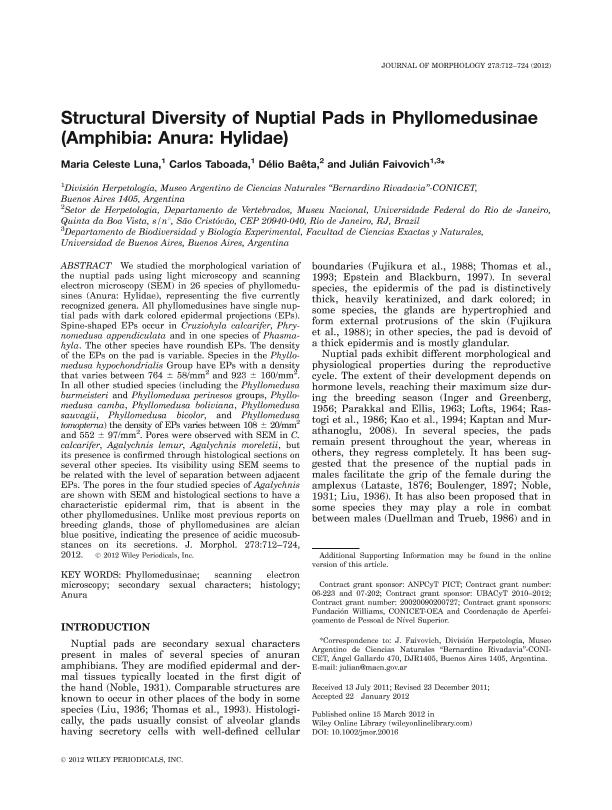Mostrar el registro sencillo del ítem
dc.contributor.author
Luna, María Celeste

dc.contributor.author
Taboada, Carlos Alberto

dc.contributor.author
Pontes Baêta Da Costa, Délio

dc.contributor.author
Faivovich, Julián

dc.date.available
2019-01-15T18:57:57Z
dc.date.issued
2012-07
dc.identifier.citation
Luna, María Celeste; Taboada, Carlos Alberto; Pontes Baêta Da Costa, Délio; Faivovich, Julián; Structural diversity of nuptial pads in Phyllomedusinae (Amphibia: Anura: Hylidae); Wiley-liss, Div John Wiley & Sons Inc; Journal of Morphology; 273; 7; 7-2012; 712-724
dc.identifier.issn
0362-2525
dc.identifier.uri
http://hdl.handle.net/11336/68060
dc.description.abstract
We studied the morphological variation of the nuptial pads using light microscopy and scanning electron microscopy (SEM) in 26 species of phyllomedusines (Anura: Hylidae), representing the five currently recognized genera. All phyllomedusines have single nuptial pads with dark colored epidermal projections (EPs). Spine-shaped EPs occur in Cruziohyla calcarifer, Phrynomedusa appendiculata and in one species of Phasmahyla. The other species have roundish EPs. The density of the EPs on the pad is variable. Species in the Phyllomedusa hypochondrialis Group have EPs with a density that varies between 764 ± 58/mm 2 and 923 ± 160/mm 2. In all other studied species (including the Phyllomedusa burmeisteri and Phyllomedusa perinesos groups, Phyllomedusa camba, Phyllomedusa boliviana, Phyllomedusa sauvagii, Phyllomedusa bicolor, and Phyllomedusa tomopterna) the density of EPs varies between 108 ± 20/mm 2 and 552 ± 97/mm 2. Pores were observed with SEM in C. calcarifer, Agalychnis lemur, Agalychnis moreletii, but its presence is confirmed through histological sections on several other species. Its visibility using SEM seems to be related with the level of separation between adjacent EPs. The pores in the four studied species of Agalychnis are shown with SEM and histological sections to have a characteristic epidermal rim, that is absent in the otherphyllomedusines. Unlike most previous reports on breeding glands, those of phyllomedusines are alcian blue positive, indicating the presence of acidic mucosubstances on its secretions.
dc.format
application/pdf
dc.language.iso
eng
dc.publisher
Wiley-liss, Div John Wiley & Sons Inc

dc.rights
info:eu-repo/semantics/openAccess
dc.rights.uri
https://creativecommons.org/licenses/by-nc-sa/2.5/ar/
dc.subject
Anura
dc.subject
Histology
dc.subject
Phyllomedusinae
dc.subject
Scanning Electron Microscopy
dc.subject
Secondary Sexual Characters
dc.subject.classification
Otras Ciencias Biológicas

dc.subject.classification
Ciencias Biológicas

dc.subject.classification
CIENCIAS NATURALES Y EXACTAS

dc.title
Structural diversity of nuptial pads in Phyllomedusinae (Amphibia: Anura: Hylidae)
dc.type
info:eu-repo/semantics/article
dc.type
info:ar-repo/semantics/artículo
dc.type
info:eu-repo/semantics/publishedVersion
dc.date.updated
2019-01-09T17:49:22Z
dc.journal.volume
273
dc.journal.number
7
dc.journal.pagination
712-724
dc.journal.pais
Estados Unidos

dc.description.fil
Fil: Luna, María Celeste. Consejo Nacional de Investigaciones Científicas y Técnicas. Oficina de Coordinación Administrativa Parque Centenario. Museo Argentino de Ciencias Naturales “Bernardino Rivadavia”; Argentina
dc.description.fil
Fil: Taboada, Carlos Alberto. Consejo Nacional de Investigaciones Científicas y Técnicas. Oficina de Coordinación Administrativa Parque Centenario. Museo Argentino de Ciencias Naturales “Bernardino Rivadavia”; Argentina
dc.description.fil
Fil: Pontes Baêta Da Costa, Délio. Universidade Federal do Rio de Janeiro; Brasil
dc.description.fil
Fil: Faivovich, Julián. Consejo Nacional de Investigaciones Científicas y Técnicas. Oficina de Coordinación Administrativa Parque Centenario. Museo Argentino de Ciencias Naturales “Bernardino Rivadavia”; Argentina
dc.journal.title
Journal of Morphology

dc.relation.alternativeid
info:eu-repo/semantics/altIdentifier/url/https://onlinelibrary.wiley.com/doi/abs/10.1002/jmor.20016
dc.relation.alternativeid
info:eu-repo/semantics/altIdentifier/doi/http://dx.doi.org/10.1002/jmor.20016
Archivos asociados
